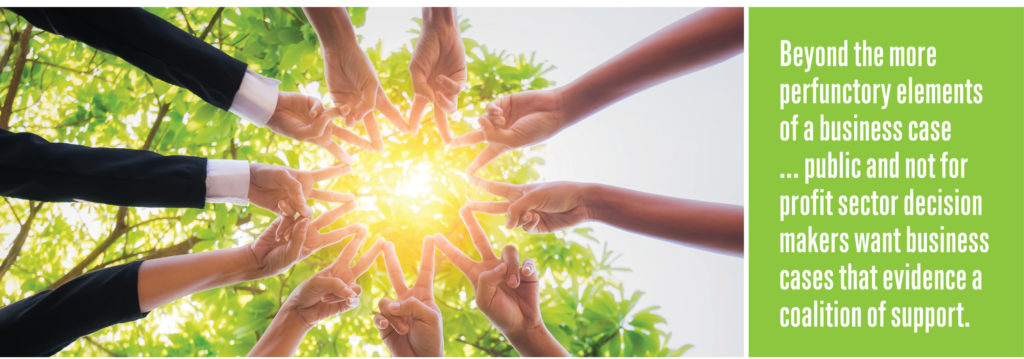Stakeholder engagement: Developing successful business cases for not for profit projects
by Chiara Lawry & Amarachi Nnah-Ogbonda
Right Thinking
In recent years, we’ve witnessed an elevation of expectations when it comes to developing business cases for government or not for profits. Business cases require evidence and a coalition of support. At Right Lane, we believe robust stakeholder engagement is the key to getting your project off the ground and for more fruitful collaboration once it is underway.

There is no shortage of business case advice around, but it mostly focuses on traditional businesses and driving profit. So, what do you do when you are asked to write a business case for government, or a not for profit?
In recent years, we’ve witnessed an elevation of expectations when it comes to writing business cases to justify spending on programs and services within government and not for profits. Decision makers want a sharper objective, a more comprehensive analysis of costs and benefits, more robust financial forecasts and greater clarity with respect to the specifics of implementation.
Perhaps most of all they want stakeholders properly consulted. Beyond the more perfunctory elements of a business case – the work to be done, the cost/benefit analyses and the models – public and not for profit sector decision makers want business cases that evidence a coalition of support.
With this in mind, we have described an approach to stakeholder engagement in support of business cases for government and not for profit projects.
‘Start as you wish to proceed’ is a maxim we hold dear at Right Lane and this is particularly important for community projects that rely on collaboration across multiple stakeholder groups for their success.
Map out your stakeholders to identify who best to engage with and build your coalition. Engage your organisation in peer-to-peer conversations with knowledgeable collaborators. Create common key messages and discussions guides and data capture templates to inform those discussions. Thoroughly mine and synthesise insights and report results and conclusions to ensure that no valuable ‘nuggets’ are overlooked.
With any project it is critical to get absolute clarity on your objective: Are you trying to realise an opportunity or are you trying to address a challenge? What are you trying to achieve?
Your objective should be SMART, specific, measurable, action oriented, relevant and timely. Also make sure it’s outcome (not activity or output) focused and ‘solved at the highest level possible’ to allow flexibility in the scope of your problem solving (Conn & McLean, 2018).
When creating your objective, consult a mix of stakeholders, both ‘insiders’ and ‘outsiders’, as you seek to understand opportunities for impact and needs. ‘Insiders’ typically have a deep appreciation of the issues you seek to address. ‘Outsiders’ have a more holistic understanding of the context your entity seeks to operate within.
‘Nihil novi sub sole’ or there’s nothing new under the sun. There may be other organisations that have attempted similar projects that you can learn from. Engage peer organisations to understand what’s been done before. Look overseas and to other industries for analogues. ‘Go to school’ on what they’ve learnt and build on what they have done.
We’ve found that insights from other organisations with relevant experiences can be particularly prescient regarding factors to consider when building your business case; issues of project governance and accountability; resourcing and funding models; and monitoring and evaluation frameworks.
This kind of consultation has the added benefit of building awareness and support for your project. Those you consult with can champion your project within the communities you seek to serve and with partners (organisations and individuals) who could support the execution of your project.
We were recently engaged to develop a business case for the transition of the African Australian Community Taskforce (AACTF) to a long-term independent entity that supports the needs of the broader African communities in Victoria. Creating a long-term independent entity required input and support from representatives of the African communities, key government organisations, and other community organisations. Embedding collaboration and consultation into how the business case was developed resulted in a robust project design and ensured that stakeholders were involved and committed to the project throughout the process.
By welcoming stakeholders into the development of your project business case, you can demonstrate your willingness to be truly collaborative, establish lines of communication and encourage diverse perspectives to push the thinking, leading to better quality, and more buy in and support. Ultimately, a more collaborative approach will put you in good stead to get your project off the ground and for more fruitful collaboration once it is underway.
References
Conn, C., & McLean, R. (2018). Bulletproof problem solving: the one skill that changes everything. New Jersey: Wiley.
We hope the ideas presented here have given you something new to think about. We would love the opportunity to discuss them with you in more detail. Get in touch today.
